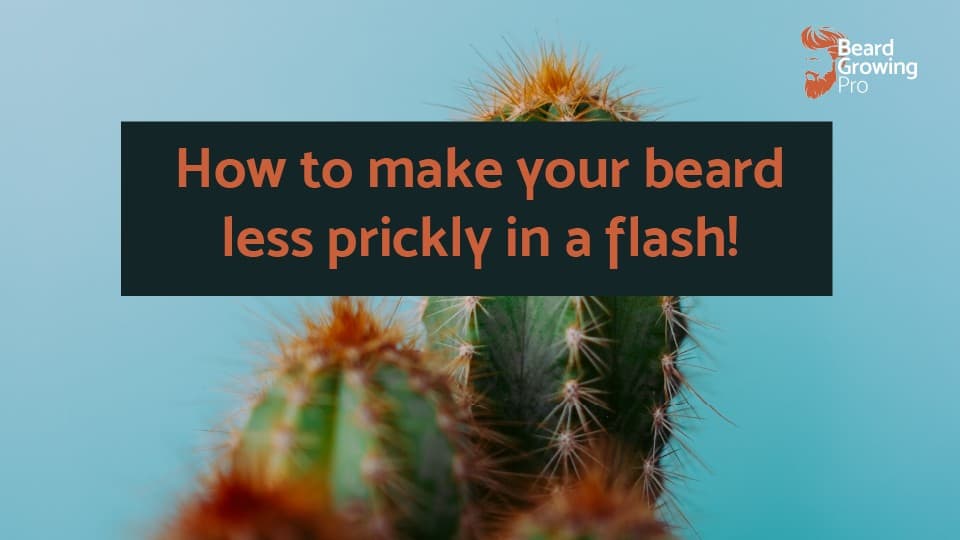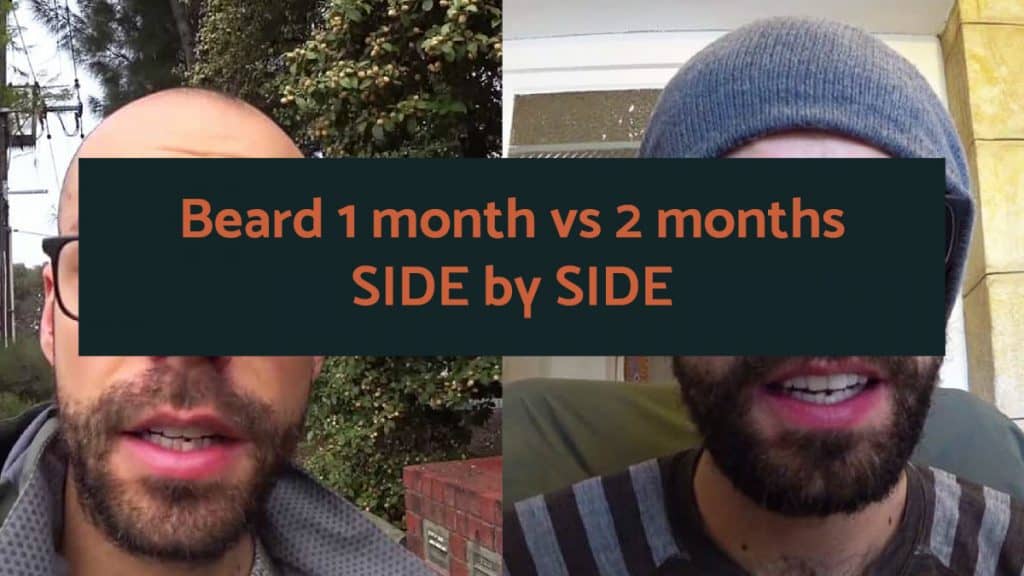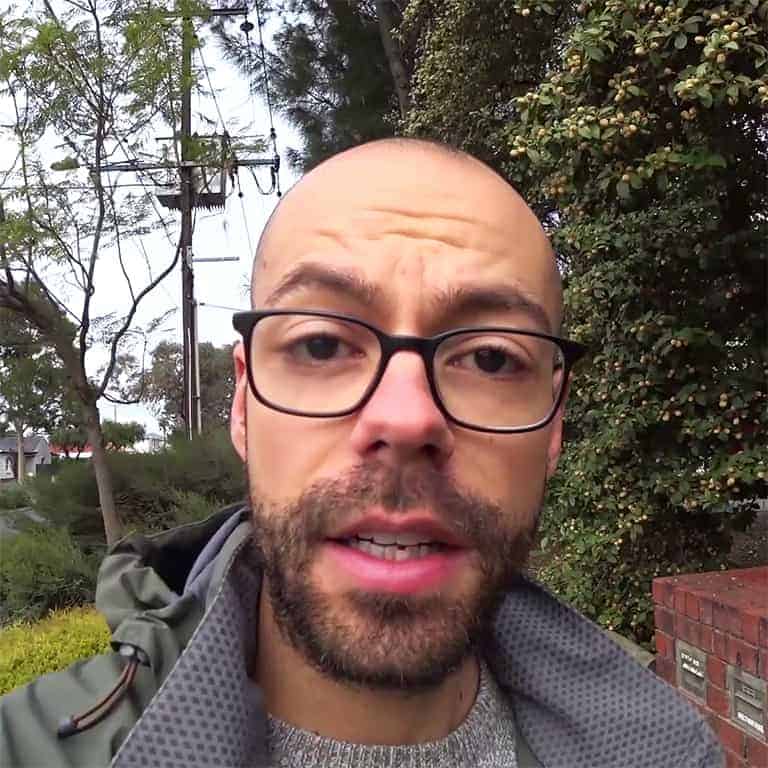In the early stages of growing a beard it can be hard to work out exactly what is changing about your beard. In the first couple of months your beard is going to change a lot. From the problems that you face to the Beard care routine that you need to adapt to – it’s going to be a journey of learning and understanding what your beard needs at different times. In this article, we are going to do a side-by-side comparison of your beard at one month versus two months. You can discover exactly what you should do differently as your beard grows.
As your beard grows between one month (half inch) and two months (one inch) you will experience different issues such as itchiness, as the hairs curl around, and a fuzziness that can be solved by trimming very lightly. The care routine will also change moving away from the skin to nourishing the hair.
Seeing your beard change as it grows in the early stages is very rewarding. Watching your beard change from stubble to full hair is something that can be relatively addictive and it means that you may be tempted to continue to grow your beard to a full length.
Let’s not get too carried away… Let’s take a look at the difference in length between one month and two months with examples from when I grew my beard.
Length 1 month vs 2 months
The early stages of beard growth means that the hair grows rapidly. It is very noticeable because in as little as one month your beard can easily double in length. As your beard gets longer the change is harder to notice and some people even think that their Beard has stopped growing.
A beard grows at approximately 0.015 inches (0.38 mm) per day which means that after about two months of growth you can expect a beard that is 0.9 inches (23 mm) long.
Your actual length will vary depending on how much your beard grows and what the coverage and density of your beard is. For most people at this stage, they are comfortably sporting what people would call “a beard.”
1 month
At one month of growing your beard can be up to half an inch in length.
Half an inch may not seem much but at this stage you have passed the stubble section of the growth and you are starting to edge into the Beard zone.
At this stage you have, hopefully, solve all of the ingrown hair issue. In this early stage ingrown hairs are much more common because your hair is growing out from your skin and if you have shaved it recently the ends of the hair can be relatively sharp which can cause them to curl around under the skin rather than sticking out.
2 months
After two months of growing your beard should be approximately 1 inch in length.
At this stage your beard is starting to look continuous across your face but, if your beard has uneven density and distribution of hair follicles you may be suffering from issues like patchiness and unconnected spots.
Also, after about two months of growth you are able to see the differences in length on different parts of your face. For example, many men have fast-growing hair on the chin area of their beard and on the cheeks and sideburns it is much slower.
Here is what my beard look like at one and two months.
My beard at 1 and 2 months
You can see that there is a significant difference between month one and month two of my beard growing. The Beard has started to fill in and started to get a little bit fuzzy around the edges.
There is no doubt that as the beard grows there a number of issues that you need to tackle – let’s take a quick look at the difference in issues between month one versus two months of growth.
Beard issues 1 month vs 2 months
Not only is growing a beard about growing hair on your face but is also about growing your skills as a beard owning person. Each person’s beard growing journey is different but, if you are willing to learn as you tackle different problems you’ll see that there are very few problems that are not able to be easily solved.
| One month | Two months |
|---|---|
| Ingrown hairs | Uneven growth rate is obvious |
| Itchiness | Patchiness |
| Spikiness | Itchiness |
| Fuzziness |
1 month
At one month you can expect beard issues such as ingrown hairs, itchiness, spikiness upon touch as well as several other inconveniences. The most common ones that you can expect I have listed below.
Ingrown hairs
Ingrown hairs can also be called razor bumps or shaving bumps. A lot of people get them after they have shaved because the sharp ends of the hair can easily penetrate the skin and cause the hair to curl around just under the surface.
Having ingrown hairs can cause a range of issues including unsightly bumps, redness, as well as potential infection if you introduce bacteria upon trying to remove them.
If you find that you’re suffering from ingrown hairs you can get them removed by your doctor who can release the hair from under the skin with a sterilised needle. There are also some other dermatologists which are trained in the service of removing ingrown hairs. You can also grab prescription remedies such as glycolic acid creams and cortisone creams.
For a lot of bearded gentlemen ingrown hair sort themselves out on their own and so you should see a doctor if it does not clear up after a couple of weeks of growing.
Try not to pick out your skin because you will end up damaging the hair follicle that we are trying to preserve.
Itchiness
It is very common for people in the first month of beard growth to experience significant itchiness.
There are a number of reasons why your beard may be so itchy and it can come down to:
- Poor hygiene – take a bath or shower every day to see if the beard itch goes away. Wash your beard with warm water if you do not have a full bath or shower.
- Dry skin – find a good moisturizer for your skin and beard
- Ingrown hairs – consider using an exfoliation scrub on problem areas of your itchy beard. This is normally pretty obvious due to the lumps and bumps that would appear on the face.
- Excessive grooming – let your beard sit for a couple of days without heat or brushing.
There are a number of home remedies that you can use to stop a beard from itching and you can check them out in my other article – what is the best itchy beard home remedy? Our top eight – click here to be taken to article.
Home remedies include clay, apple cider vinegar, peppermint leaves, aloe vera, baking soda, coconut milk, and coconut oil – these are things you probably have in your pantry right now.
Spikiness
As you are great at your beard you may find that it becomes very spiky. Beard hairs are fat and thick. This is because the hair papilla – where the hair grows in your skin – is much larger than any other part of your body. Roughly, the hair on your face is about four times the size of the hair papilla on your scalp.
As beard hairs emerge from your face they are anchored to your skin by the hair route. This, along with the fat hair means that when you touch it is not able to move out of the way, or yield, and so it feels spiky. Along with that, if you have recently trimmed or shaved your beard it can have a certain spikiness to the end as the hair tapers.
Growing it out another month – to the two-month length will help keep the beard from being spiky. If you want to keep it at this length you can choose a good beard conditioner such as Shea butter or coconut oil to soften up the hairs and allow it to become more flexible and less spiky.
2 months
At two months of growth you have overcome many of the issues that you’ve encountered at month one. That doesn’t mean that you are free and in the clear and you will almost certainly notice other issues pop-up. These are some of the most common ones that beard growers notice after about two months of growth.
If you want to know more about two months of beard growth check out my other article – is two months enough to grow a beard? Styles, tips, and more – click here to be taken to article.

Uneven growth obvious
An uneven growth rate is very common and is much more obvious as your beard starts to connect and grow beyond half an inch in length. For many people the strong growth area is around the chin and moustache area and the cheeks fall behind. An uneven growth rate can be covered up by growing out your beard longer or you can trim off the longer parts of the hair to even it up to match the short sections.
Patchiness
A patchy beard is very common in the early stages of beard growth. When beard hairs are only 1 inch in length they can struggle to cover up any low-density coverage areas of your beard. It is relatively easy to cover up patches once your beard gets over 3 inches in length.
Before that, however, you should keep your beard nice and soft so that it is much easier to comb into shape. You can achieve that using beard oil and other beard conditioners or softeners.
Itchiness
Another issue which is very common in beards that are only two months old is that they are itchy. 1 inch worth of hair is enough to allow the hair to curl around and irritate the skin underneath. If you have particularly curly beard hairs you need to make sure that you condition and soften the hair and use a good quality pair of scissors which cleanly cut off the ends during trimming.
If you want to know more about how to make your beard less prickly check out my other article – how to make your beard less prickly in a flash – click here to be taken to article.

Fuzziness
Lastly, you are likely to see some fuzziness around the edges of your beard. This is because at 1 inch in length your beard is able to curl around and no longer point directly out from the skin. This means that you don’t have a defined edge on the beard anymore and this can look like a little bit of tennis ball fuzz on the edge of the beard.
You can choose to trim and line up the beard using a good set of beard trimmers. Use a trimming guard which will allow you to make all of the hair is the same length. You will have to get used to passing over the face in a number of different directions since not all hair grows the same direction and it will start to curl around on itself.
Here are some tips and tricks for trimming up your beard at one month versus two months of length.
Trimming: 1 month vs 2 months
trimming up your beard doesn’t require too much in the early stages. However, some people feel like they want to trim up their beard in the early stages so that it looks better, and also gets rid of some of the horrible side effects such as edginess which can occur at the crease of your neck.
1 month
At one month you are probably facing some common issues such as irritation and itching under the neck. There isn’t too much you can do other than line up the beard under the neck and trim your neckline.
Getting rid of the hair as it bunches up in the crease of your neck will help minimise the irritation that you feel. You can also choose to remove the hairs on your cheek line which cause an uneven and undefined line between your cheek and your beard.
Line up
The first things I would check and focus on are the cheek lines and necklines of your beard.
Cheek line
The cheek line should flow nicely from the top of your moustache to the front edge of your sideburns.
Exactly how deep the curve dips into your cheek or if you want it straight that is completely up to you. The most important thing is that it is the same on both sides. You can decide to use a beard guide with your beard trimmer before shaving to define the line.
Neckline
There are ton of things that you can get wrong with a neckline. Ultimately, you do not want to churn it too far up under your jaw and it needs to follow the line where your head connect to your neck. Do not be tempted to trim up underneath the jaw as that will end up making your beard look less substantial and if you have a patchy beard it will make it look almost non-existent.
2 months
At two months this is when you can consider putting in more definite lines in your beard. This is because you now have gone much better idea about where your maximum growth density is and you will be able to use the information to
Trimming
Every week or so I recommend that you do a 1 inch trim up using your trimmer and guard if you want to keep your beard at this length.
To get it to cut reproducibly you will need to sweep over your beard in multiple directions so that you are able to catch the beard hairs that curl in strange directions.
Your beard likely has a number of different growth directions and therefore sweeping in multiple directions in a slow and controlled manner will mean that you will be able to cut every single hair on your face to 1 inch.
It is this level of precision that will make your beard go from good to great and give it that extra lift in terms of its style.
Fading
After you’ve trimmed up your beard to 1 inch all over you can choose to fade into less thick parts of your beard using a shorter trimmer guard.
This is more of an advanced technique and it will take a little bit of practice. If you’re not quite sure how to fade into certain areas of your beard I would recommend getting in contact with your local barber and asking them to give you a demonstration on the best ways to trim up your beard so that it looks professional.
Line up
Line up your beard just like you did at one month. However, this time you’ll have a much better idea of exactly where the line should set as you will be fully aware of the maximum growth density of your beard. I recommend taking off any beard hairs that have escaped beyond the line of maximum density with a single blade safety razor which will give you the best accuracy for trimming.
Summary
In this article, we have gone over differences between a beard after one month and two months worth of growth.
As your beard grows not only with the hair get longer but you will also need to use different skills to combat the problems that arise as you are growing your beard. Continuously learning and allowing yourself to try new things will allow you to overcome the problems much quicker.
Most people find it growing a beard is a very worthwhile experience and after a couple months of growth they commit to growing a much longer beard. If you want to know how to grow along beard check out my other article – how to prolong beard five simple tips.





